Pesto is a bright and flavorful sauce that you can add to just about anything. It’s packed with simple but beautiful flavors of fresh basil, pine nuts, garlic, olive oil, and dry aged cheese like Parmesan, Parmigiano-Reggiano, or Pecorino.
Our family’s favorite way to use basil pesto is in Pesto Pasta. It’s also amazing with Sun-Dried Tomato Pesto!
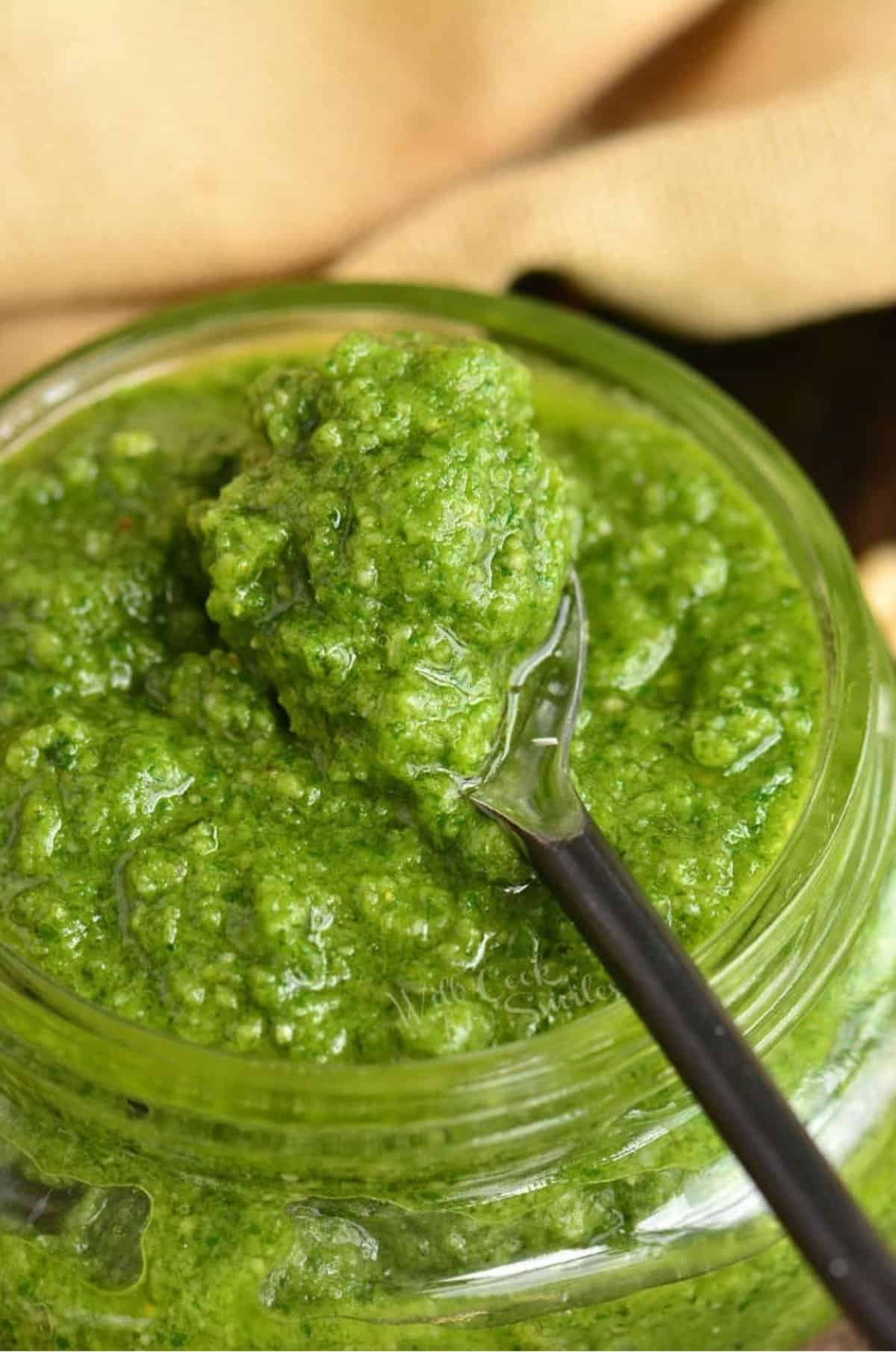
Table of Contents
What Is Pesto?
Pesto is an amazing uncooked sauce that originated in Genoa, Italy. Literally translated, it means “pounded” or “crushed” because it was originally made using mortar and pestle. In our modern days, we have the technological advances and availability of a food processor, which we use eagerly. It’s fast and much more efficient. Although, I doubt that it will ever provide the same texture and flavor as making pesto by hand.
This classic sauce is fresh, aromatic, with an amazing smooth and flavorful taste. Even though there are hundreds of recipe variations that use different nuts, herbs, and cheeses, you can never compete with the classics. Traditional pesto consists of six simple ingredients: basil, garlic, olive oil, dry aged cheese, pine nuts, and salt.
It is incredibly easy to make and all you need is a blender. (Unless of course, you want to give yourself a workout and use mortar and pestle.) Within 5 minutes, you will have this incredible sauce to add to pasta and so many more dishes. It’s rare that I don’t have a jar in my fridge or some in my freezer.
My son loves pesto pasta and pesto pizza so I’m always happy to oblige. I also love to spread some pesto on sandwiches and mix it into salads.
Ingredients In Pesto
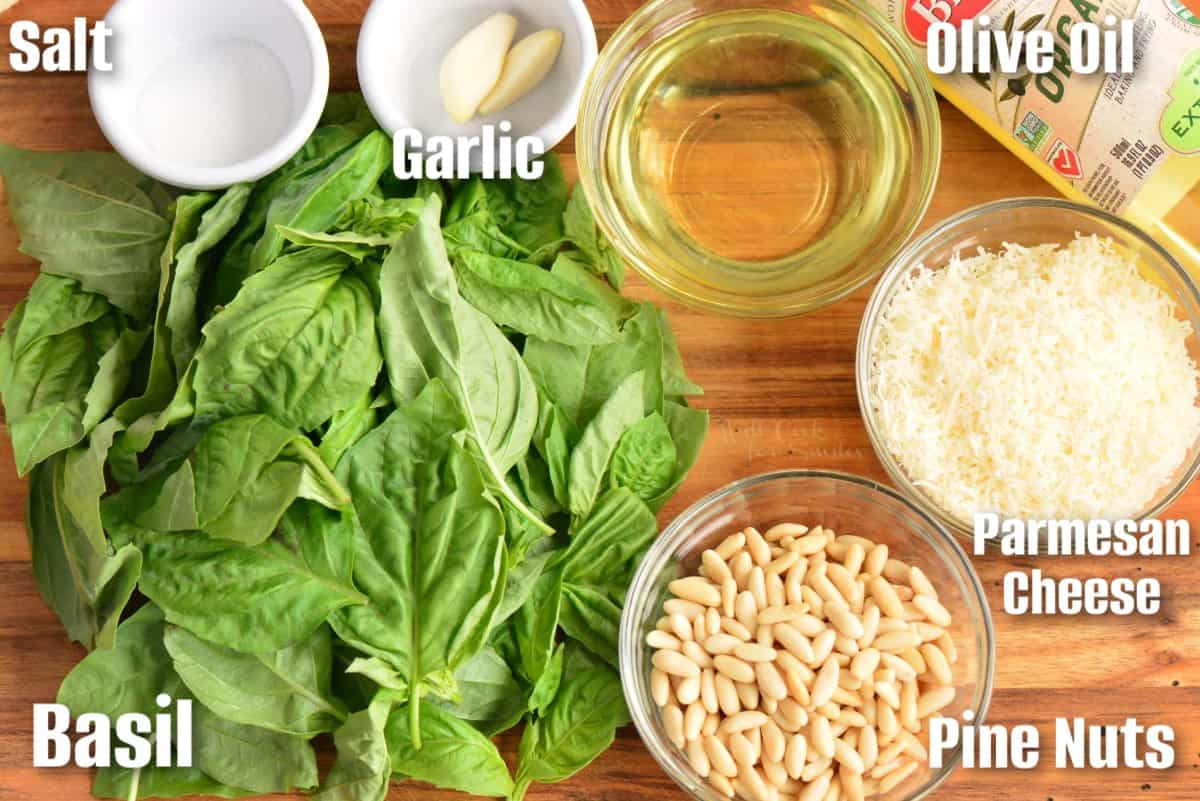
Basil – ideally, you want to get basil that is as fresh as can be. If you have an herb garden, that is perfect. Otherwise, you can always get basil in the produce department of your grocery store.
Pine nuts – these nuts are preferred to use in pesto and the most traditional one. They have a subtle earthy, sweet flavor that is not overpowering. I do not toast my pine nuts because I truly saw no difference in taste when blended with other ingredients. Many people like to substitute walnuts but I find walnuts to have a strong flavor. I’ve successfully used cashews as a substitute but they tend to be creamier when blended.
Garlic – fresh garlic is best, of course. No need to press or mince garlic before adding it to the food processor. Although, if using a large garlic clove, you may want to cut it in two or more pieces to make sure it’s blended well.
Cheese – use dry, aged cheese like Parmesan, Romano, Parmigiano-Reggiano, or Pecorino. My personal favorite is Parmigiano-Reggiano.
Olive oil – flavor of olive oil is key. If the olive oil you use has a strong, almost bitter flavor, it will affect the taste of pesto. Use olive oil that you know and like the flavor. I highly recommend that you taste the oil first, before adding to the blender.
Salt – don’t use too much, remember that dry aged Italian cheeses tend to be quite salty. Start small and taste after pesto is blended to see if you need more.
How To Make It and Tips
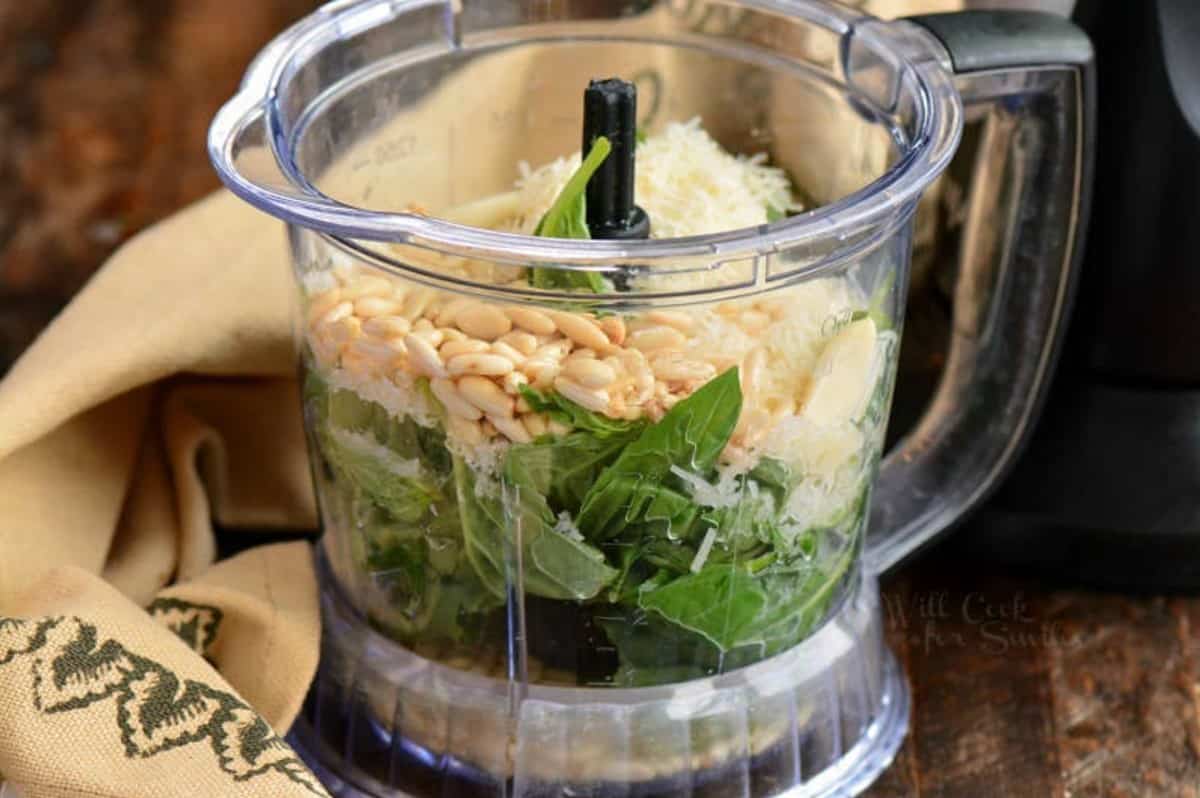
When you make something so much, technique and amount of ingredients becomes a like a second nature. It also means that I’ve tried dozens of different techniques and variations. Since I originally posted this recipe in 2011, I’ve improved my recipe greatly and found the best and easiest way to make delicious pesto. You truly don’t need 10 different steps and orders to add your ingredients. It literally comes out the same in the end. There are only a few rules that I follow:
1- Make sure your ingredients are fresh and the best. In a simple sauce like that, each ingredient count.
2– Add half the oil in the beginning and the other half while pulsing.
3– Pulse, don’t blend.
4– Drizzle a little extra olive oil over the top of pesto after transferring it into a glass jar. I find it helpful to prevent the top of pesto getting dark. (Although, it is still completely safe even if it does get dark. That is simply oxidation.)
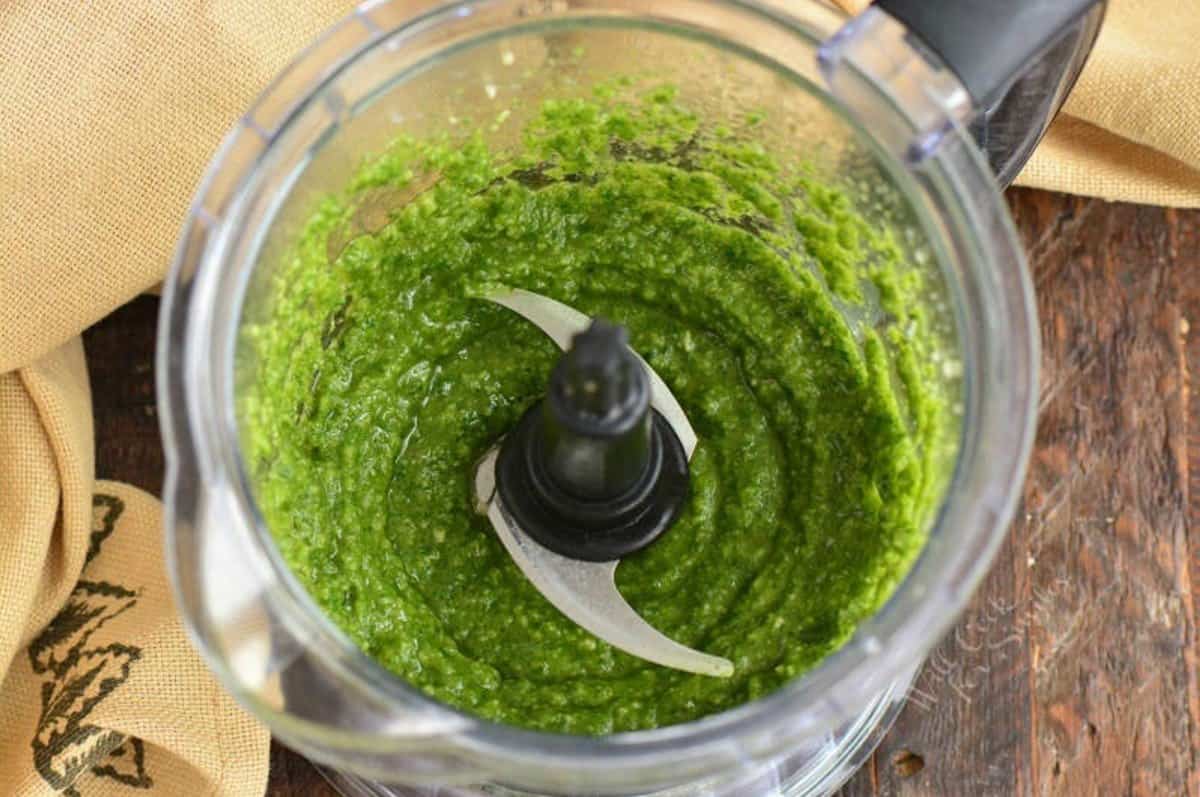
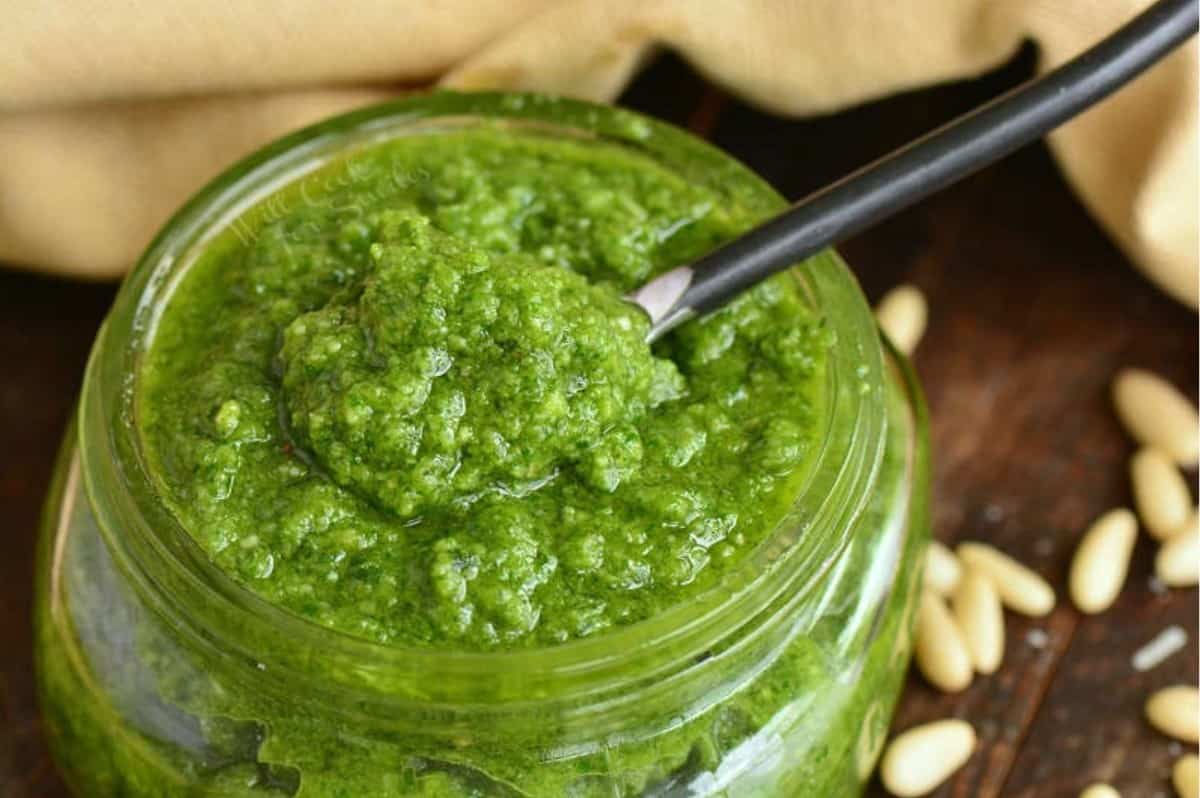
Recipe FAQs
Store homemade pesto in small glass jars with an air-tight lid. I like to divide the batch into 2 or 3 small jars that way I will not open it too often. After you fill the jar, drizzle a little olive oil over the top and close it tight with a lid. Store in the refrigerator for up to a week.
Absolutely! The purists will undoubtable scald me for even saying it but you can use other nuts in a basil pesto. Traditionally, pine nuts are the nut of choice but some other region of Italy and Sicily have used walnuts instead. Personally, I’ve used almond and cashews to make pesto. Cashews are my personal favorite substitution because, like pine nuts, they are also mild in flavor and don’t take over the pesto.
Yes, this is a gluten free recipe for the basil pesto but I always recommend double checking the packaging notes on the ingredients.
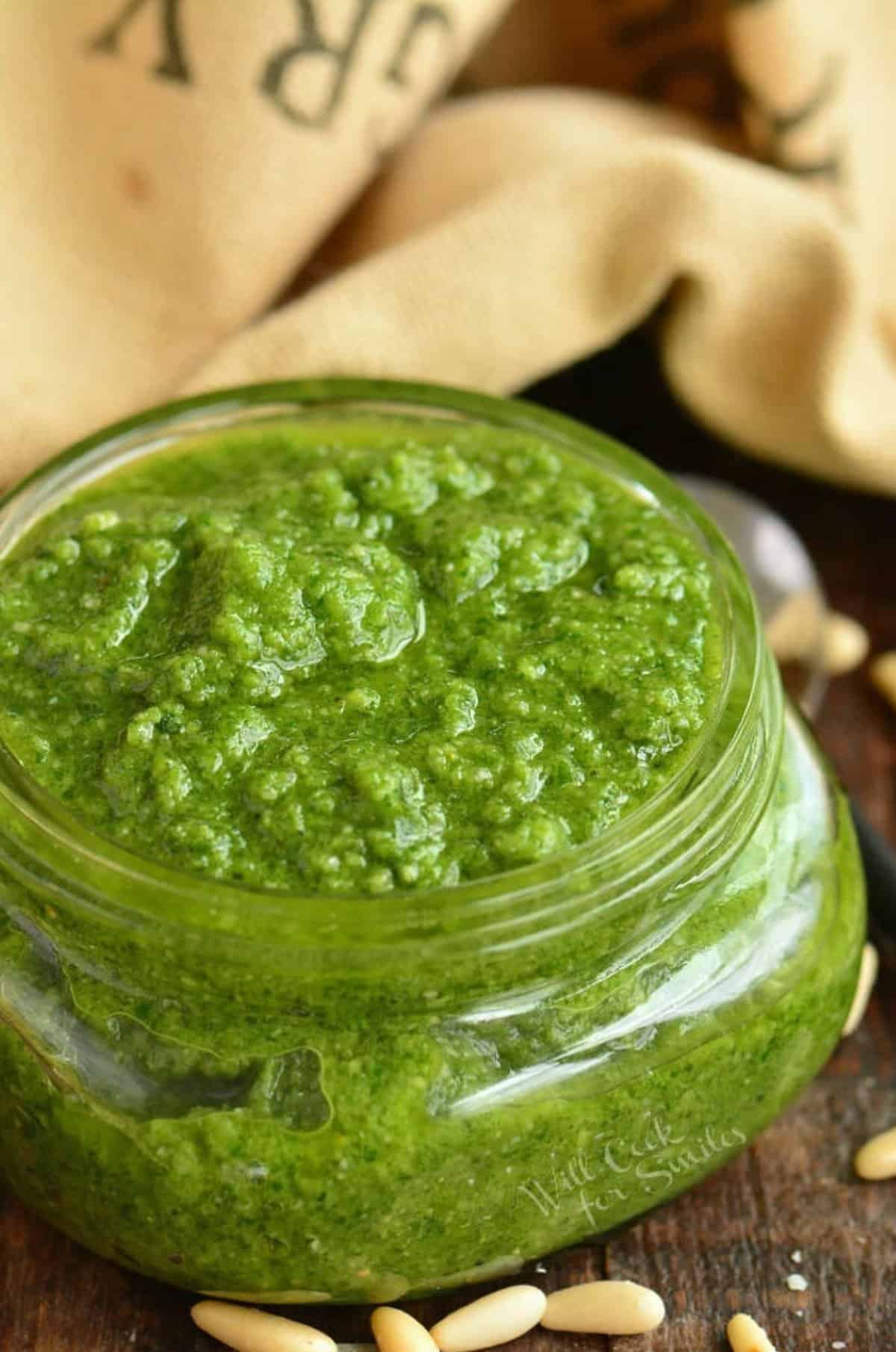
Freezing Instructions
Basil pesto freezes beautifully and you can portion it into small amounts of freeze 1/2 cup or a cup at a time.
Small portions: use ice cube trays and divide ready pesto among the cups. Drizzle a small amount of olive oil over the top of each cup. Freeze for 2-3 hours until it’s completely frozen and then transfer the pesto cubes into a freezer zip-lock bag. Label and place back in the freezer.
Larger portions: transfer either 1/2 cup or 1 cup portions of pesto into freezer zip-lock bags. Get all the air out and seal each bag. Label and freeze for up to 4 months.
How To Serve Pesto
Pesto is so versatile, you can use it in many dishes from breakfast to dinner!
You can use it as an appetizer, dip, or spread on a crostini, crackers, and veggies.
Try mixing it with pasta or spreading it over meats like chicken and salmon.
You can add it to a white lasagna or a classic lasagna.
Mix it with Alfredo sauce in a simple comforting pasta dish. It’s also great mixed with gnocchi.
Add a dollop to caprese salad. (get some links in here) Spread some on my caprese bread (it’s divine!)
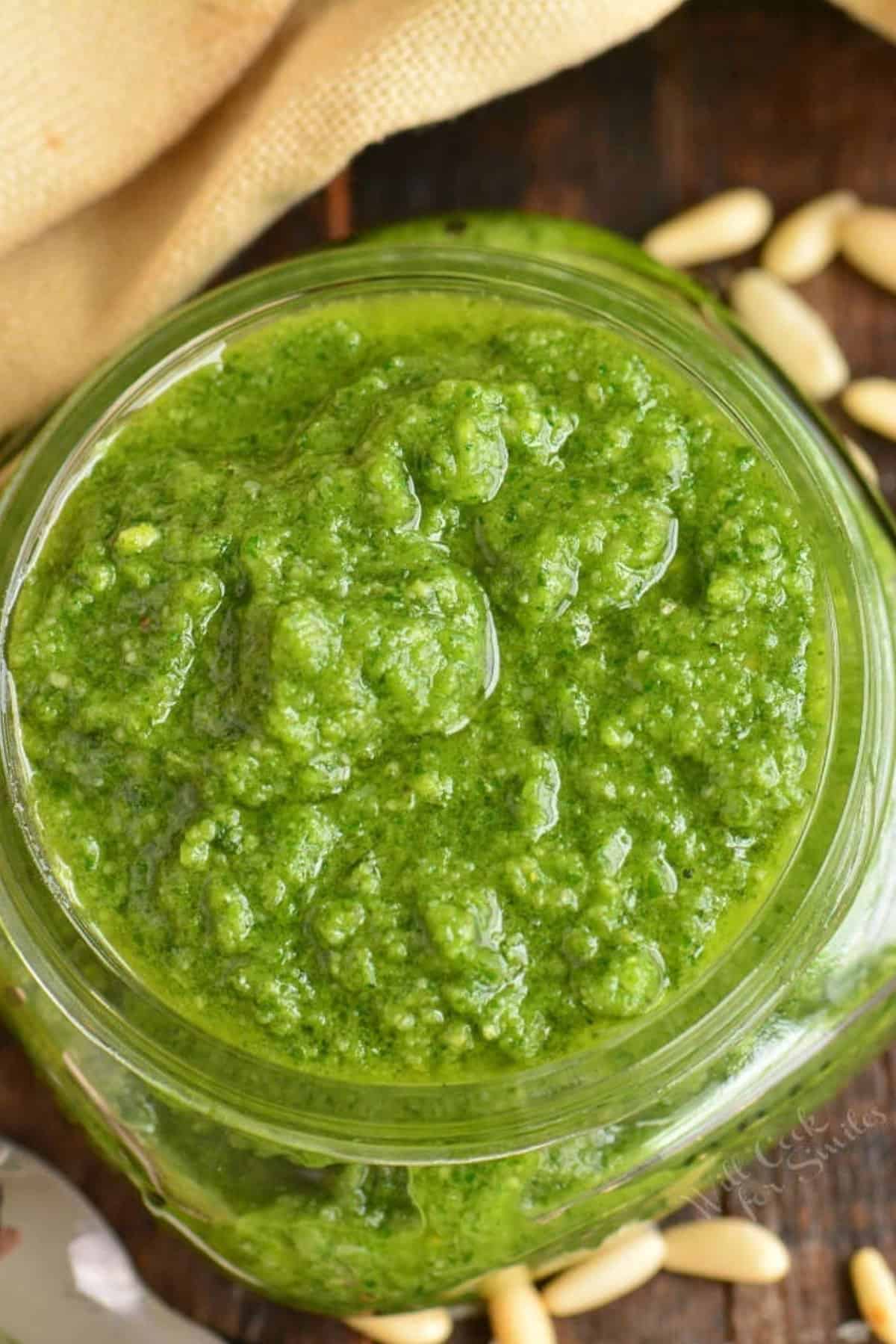
Some More Recipes That Use Pesto
DID YOU MAKE THIS RECIPE? PLEASE leave a 🌟 star rating! Let me know how you liked it by leaving the 📝 comment below or share and tag me on social media @willcookforsmiles. DON’T FORGET to subscribe to my newsletter!
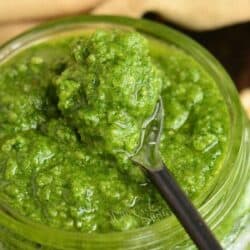
Classic Pesto Recipe
Ingredients
- 2 oz basil about 2 cups packed
- 2 garlic cloves
- 2 oz shredded Parmesan cheese about 2/3 cup
- 3 oz pine nuts
- 1/2 cup olive oil (+2 Tbsp)
- Salt
- a little more olive oil to drizzle over the top when divided into jars
Instructions
- In a food processor, add about half the oil.
- Add basil, pine nuts, cheese, garlic, and salt to the blender and pour remaining olive oil over the top.
- Pulse several times to begin to blend. Scrape sides of the blender and pulse a few more times. You may need to scrape the sides again and pulse a few more times until all ingredients are well blended.
Video
Notes
Nutrition
Originally Published on Will Cook For Smiles on August 24, 2011.











Kathleen says
Long time fan, first time commenter…
I’ve been making your recipe for the past few years. It’s absolutely perfect, really tasty, easy to make and never disappoints. My extremely picky son loves it! I always make a double batch and either gift the second jar or make pesto cubes to use throughout the year. Thank you!
joanne harward says
when making pesto, do NOT use the flowers or stems. makes it bitter..i like cashew nuts.. makes it creamy (can not buy any fresh pine nuts here, i’ve used walnuts..just make sure they are FRESH) i remove the flowers just as soon as they appear, all the energy goes to produce more leaves,..towards the end of the season i let the flower go to produce seed for next year …will try this receipe…sounds like keeper….
Mary Ramsey says
I just made this recipe and it is so good I’m eating it on crackers. Hope there’s enough left to put on the pasta for dinner!!! BTW, I didn’t have pine nuts, but did have walnuts, so I toasted them and….. WONDERFUL!!!
LyubaB says
Mmmm yum! I am glad the walnuts were good with it, thanks for letting me know! 🙂
K. Gianandrea says
The best Pesto recipe I’ve found. What makes it the best, the technique, oil in first, then basil etc. also pulse, not blend. Have made this multiple times and turns out perfect, always, thank you.
LyubaB says
Aww thank you! That makes me so happy that you like it so much!
Miz Helen says
Hi Lyuba,We grow our own basil and making pesto is so much fun. Your recipe sounds great, I will give it a try. Hope you are having a great week end and thank you so much for sharing with Full Plate Thursday.Come back soon!Miz Helen
Mary-Sweetwater Style says
Now I can make something besides alcoholic drinks and ice cream in my new Vita Mix….that is if I sell my first born for the price of the pine nuts. Loved your post!
Lady Behind The Curtain says
My basil is almost a tree. I guess it’s time to harvest and make some pesto! Thanks for sharing this recipe at Cast Party Wednesday. I hope to see you again next week.
Angela says
If you want to be true ‘Italian Pesto’ you have to use the pine nuts and pecorino cheese, do not get to hear from Liguria that uses nuts and Parmesan cheese!
Angela very Italian gourmet
Cindy says
My basil plant is doing great too. Pesto is the best–I think I will make some today. Thanks for the recipe. Have a great day.